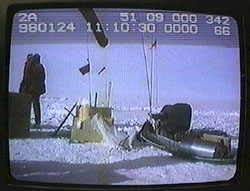
|

|
|
|
©
Per Olof Hulth
|
|
|
Preparation
for drilling holes for AMANDA's optical sensors begins
with a sled bringing equipment.
|
|
|
|

A
literary essay about AMANDA by Francis Halzen
Big
science, as often as not, hinges on small moments. Once the
grants have been secured and the politics navigated, the ground
broken and the visionary promises made, when banks of computers
flicker to life and fingers curl above keyboards, ready to
flash the first discoveries via E-mail, a decade’s work
can still come crashing down in the final hour—a castle
erected in the thin air of theory, too weak to withstand true
gravity.
Last
August, when Dennis S. Peacock came to visit my office at
the University of Wisconsin-Madison, he must have had something
like that in the back of his mind. As the head of the Antarctic
sciences section for the National Science Foundation (NSF),
Peacock had helped funnel some $10 million into building the
world’s largest neutrino telescope deep in the Antarctic
ice. Would we have anything to show for the investment? Or
would our project go the way of its predecessor, partly built
in seawater off the coast of Hawai’i and then abandoned
after nearly twenty years of work?
Our telescope—also known as the Antarctic Muon and Neutrino
Detector Array, or AMANDA—had been detecting neutrinos
for some time, but we had yet to finish analyzing our first
data. Or so I thought. Instead, when Peacock and I arrived
at the desk of my graduate student, Rellen R. Hardtke, she
had a surprise waiting for me. Two of her colleagues had spent
the night finishing the analysis, she explained with a smile.
Then she calmly called up an image on her computer screen:
the first precision map of a high-energy neutrino event ever
recorded.
Hardtke’s screen showed a faint blue line streaking diagonally
across columns of black dots. Most of the dots, each of which
represented a photomultiplier sunk in the ice, were small
and black. But a few, clustered along the line, were blue
or green or red, and two, near the beginning of the line,
were bright orange and very large. At five in the morning
on October 12, 1997, the diagram told us, a neutrino—one
of nature’s smallest and most elusive elementary particles—had
entered the earth in the middle of the Pacific Ocean, between
Midway Island and the Aleutians, hurtled straight through
the planet, and collided head-on with a proton on the underside
of the Antarctic ice. Two kilometers beneath the surface,
our grid of photomultipliers had picked up a subatomic spark
from that collision as it flew upward through the ice and
flared past them for about a microsecond.
|
